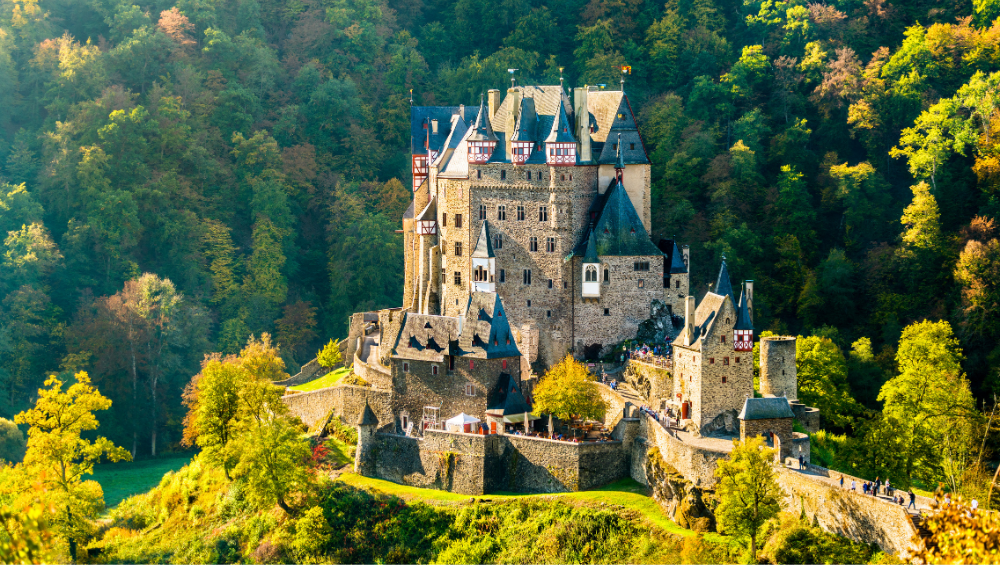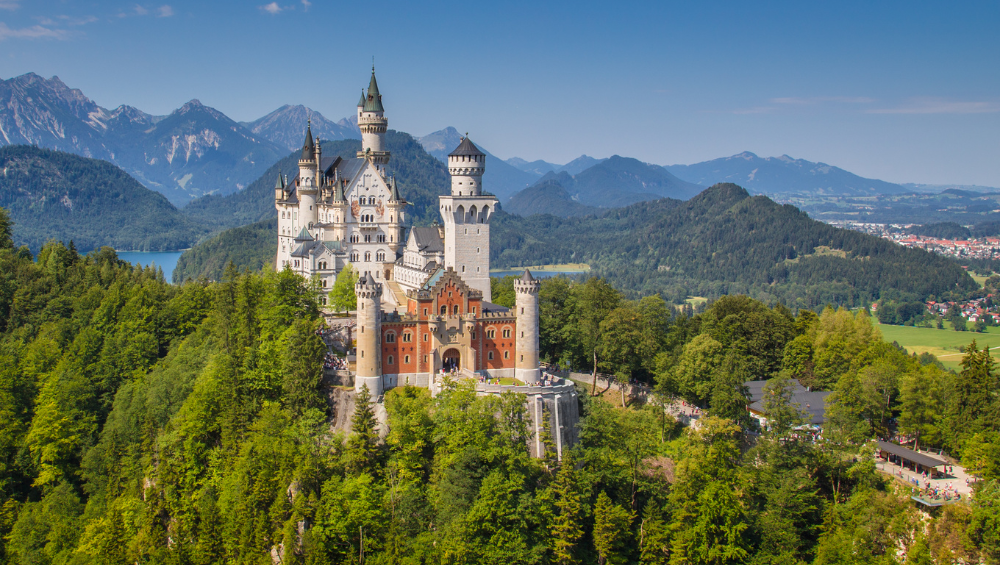Table of Contents
Germany is home to some of the most majestic and fascinating castles in the world. Whether you are looking for romantic palaces, impressive fortresses, or an unforgettable fairytale castle experience – Germany has it all. From stunning medieval structures to picturesque roads lined with towering turrets – a visit to these 10 breathtaking German castles will provide lasting memories and delight your inner adventurer.
Join us on this magical journey through history as explore the stunning architecture, legend-filled tales, charming townships – and of course lots of delicious local German delicacies.
10 Stunning Castles in Germany
If you’re a history buff or simply enjoy exploring beautiful destinations, then you’ll definitely want to add German castles to your travel bucket list. With over 20,000 castles and palaces, Germany is a haven for stunning architectural gems, many of which are located in picturesque settings. From the Neuschwanstein Castle, said to have inspired Walt Disney’s iconic Cinderella Castle, to the eerie Burg Eltz Castle that is still owned by the original family after over 850 years, there’s no shortage of visually and historically captivating castles in Germany.
Check out these top 10 must-visit castles in Germany:
1. Burg Eltz
Burg Eltz is a medieval castle that is located in the western German state of Rhineland-Palatinate. The castle is situated on a rocky outcrop above the village of Moselkern and overlooks the Moselle River. Burg Eltz has been inhabited by the same family for over 850 years and is one of the few castles in Germany that has never been destroyed.
2. Schloss Neuschwanstein
Schloss Neuschwanstein is a 19th-century castle that is located in the southern German state of Bavaria. The castle was commissioned by King Ludwig II of Bavaria and was intended to be a private retreat for the king. Due to Ludwig’s untimely death, the castle was never completed. Schloss Neuschwanstein is one of the most popular tourist destinations in Germany, with over 1.4 million visitors each year.
3. Schwerin Castle
Schwerin Castle is a Gothic castle that is located in the northern German state of Mecklenburg-Vorpommern. The castle sits on an island in Lake Schwerin and is surrounded by a moat. Schwerin Castle has been the seat of the Mecklenburg-Vorpommern state parliament since 1990 and is also home to a museum and art gallery.
4. Wartburg Castle
Wartburg Castle is a medieval castle that is located in the eastern German state of Thuringia. The castle was built in 1067 and served as a fortress for the Landgraves of Thuringia. In 1817, the castle was transformed into a palace by Duke Ernst I of Saxe-Coburg and Gotha. Wartburg Castle is a UNESCO World Heritage Site and houses a museum dedicated to Martin Luther.
5. Hohenzollern Castle
Hohenzollern Castle is a 19th-century castle that is located in the southwestern German state of Baden-Württemberg. The castle was built on top of an existing medieval fortress and served as the ancestral seat of the Hohenzollern dynasty until 1918. Hohenzollern Castle is open to the public and houses a museum about the history of the Hohenzollern family.
6. Heidelberg Castle
Heidelberg Castle is a ruined castle that is located in the southwestern German state of Baden-Württemberg. The castle sits atop Heidelberg Hill overlooking the city of Heidelberg. Heidelberg Castle was first built in 1214 but has been destroyed and rebuilt several times over its 800-year history. Only ruins remain but Heidelberg Castle remains one of Germany’s most popular tourist destinations with over 1 million visitors each year.
7. Lichtenstein Castle
Lichtenstein Castle is a 19th-century castle that is located in the southwestern German state of Baden-Württemberg. The castle was built as a hunting lodge and was inspired by the novel “The Song of the Nibelungs”. Lichtenstein Castle serves as an events venue and is open to the public.
8. Schloss Charlottenburg
Schloss Charlottenburg is a baroque palace that is located in the western German state of Berlin. The palace was built in 1695 by Elector Friedrich III and served as his summer residence until he became King Friedrich I in 1701. Schloss Charlottenburg is open to the public and houses a museum, art gallery, and park.
9. Castle Pfalzgrafenstein
Pfalzgrafenstein Castle is a medieval castle that is located in the western German state of Rhineland-Palatinate. The castle was built in 1326 as an outpost for controlling the shipping on the Rhine River. Pfalzgrafenstein Castle is an example of a “fairy tale” castle and has been featured in films such as The Three Musketeers.
10. Linderhof Palace
Linderhof Palace is a 19th-century palace that is located in the southern German state of Bavaria. The palace was built by King Ludwig II of Bavaria and is the only one of his three palaces that was completed during his lifetime. Linderhof Palace serves as a museum and visitors can explore its stunning gardens, grottoes, and fountains.

History of German Castles
Germany is a country steeped in history and its castles are the perfect way to explore this past. There are many different types of castles scattered across Germany, from medieval fortresses to 19th-century palaces. These captivating structures were built over centuries and each one has a unique story to tell. From tales of war and conquest to stories of romance and alliance, the castles of Germany provide an opportunity to step back in time and explore the country’s rich history.
The first castle was built in Germany during the 10th century. As the Middle Ages progressed, these fortresses began to become more elaborate and luxurious, often serving as royal residences for powerful rulers. During this period, many of the most iconic German castles were built, including the Neuschwanstein Castle and the Wartburg Castle. By the 19th century, castle building had become a popular pastime among wealthy aristocrats who wanted to display their wealth and power.
There are thousands of castles in Germany that range from well-preserved fortresses to crumbling ruins. These captivating structures serve as a reminder of the country’s fascinating history and are popular tourist attractions. Whether you’re looking for a grand palace or an ancient ruin, there is sure to be a castle in Germany that will captivate your imagination.
Cities & Towns around Castles in Germany
Germany is home to many castles, each one situated in a unique and picturesque location. Here are some of the major cities and towns that are within close proximity to many of Germany’s most popular castles:
1. Heidelberg
Heidelberg is a city in southwestern Germany that is home to Heidelberg Castle, a ruined castle that sits atop a hill overlooking the city. The castle was built in the 13th century and was later destroyed by French troops in the 17th century. Today, the castle is a popular tourist destination, with over 1 million visitors each year.
2. Dresden
Dresden is a city in eastern Germany that is home to Dresden Castle, a Baroque palace that was once the residence of the Kings of Saxony. The castle was built in the 18th century and was severely damaged during World War II. Today, the castle has been rebuilt and is open to the public as a museum.
3. Hamburg
Hamburg is a city in northern Germany that is home to Hohenzollern Castle, a castle that was once the primary residence of the ruling family of Prussia. The castle was built in the 19th century and today serves as a museum and event venue.
4. Berlin
Berlin is the capital of Germany and is home to Charlottenburg Palace, a large palace that was once the primary residence of the ruling family of Prussia. The palace was built in the 17th century and today houses a museum, art gallery, and library.
5. Munich
Munich is a city in southern Germany that is home to Nymphenburg Palace, a large Baroque palace that was once the primary residence of the ruling family of Bavaria. The palace was built in the 17th century and today houses several museums, including an art museum and a porcelain museum.
6. Cologne
Cologne is a city in western Germany that is home to Cologne Cathedral, one of Germany’s most famous landmarks. The cathedral was built in the 12th century and is known for its Gothic architecture and twin spires. The cathedral is also home to the Shrine of the Three Kings, which contains relics believed to be from the biblical magi.
7. Düsseldorf
Düsseldorf is a city in western Germany that is home to Schloss Benrath, a large Baroque palace that was once used as a summer residence by members of the ruling family of Prussia. The palace was built in the 18th century and today houses several museums, including an art museum and natural history museum.
8. Frankfurt
Frankfurt am Main is a city in central Germany that is home to Frankfurt Castle, a large castle that served as a fortress for much of its history. The castle was built in the 13th century and today houses several museums, including an armory museum and a torture museum.
9. Stuttgart
Stuttgart is located in southwestern Germany and it’s one of Europe’s greenest cities with more than half of its area made up of forest parks such as Killesberg Park or Rosenstein Park – perfect for hiking or picnicking on warm days! On top of all that nature, Stuttgart boasts some incredible architecture like its New Palace (Neues Schloss) which took over 100 years to build starting in 1746!
By exploring the castles of Germany you can gain an appreciation of the country’s remarkable history and culture. From famous fortresses to lesser-known ruins, these captivating structures provide insight into how people lived centuries ago. Whether it’s a grand palace or a historic ruin, each castle has its own story to tell that will leave you spellbound.

10-Day Itinerary for the Castles in Germany
Embarking on a 10-day itinerary to explore the castles in Germany is an adventure you’ll never forget. Traveling to different locations rich with history and culture, you’re sure to marvel at the grandeur of each castle and appreciate the stories behind them. From the Neuschwanstein Castle to the medieval Heidelberg Castle, each stop will leave you in awe of the beautiful architecture and captivating surroundings.
Day 1: Heidelberg & Hohenzollern
- Start your journey in Heidelberg and visit Heidelberg Castle. Explore its impressive ruins and enjoy panoramic views of the city.
- In the afternoon, head to Hohenzollern Castle, located near Stuttgart. Take a guided tour of this majestic castle and learn about its history and architecture.
- Spend the night in the area.
Day 2: Neuschwanstein Castle
- Travel to Neuschwanstein Castle, one of Germany’s most iconic castles. Explore the fairytale-like interior and enjoy the stunning surroundings of the Bavarian Alps.
- Afterward, you can visit the nearby Hohenschwangau Castle, which offers another beautiful perspective of the area.
- Overnight near Neuschwanstein Castle.
Day 3: Wartburg Castle & Lichtenstein Castle
- Drive to Wartburg Castle, situated in Eisenach. Take a guided tour and discover the rich history of this UNESCO World Heritage Site.
- In the afternoon, continue your journey to Lichtenstein Castle. Admire its dramatic location perched on a cliff and explore its medieval-inspired interiors.
- Stay overnight in the region.
Day 4: Schwerin Palace
- Travel to Schwerin Palace in the city of Schwerin. Explore the opulent rooms, lush gardens, and the island on which the palace is situated.
- Don’t miss the Schwerin Cathedral and the picturesque Old Town nearby.
- Spend the night in Schwerin or its surroundings.
Day 5: Burg Eltz
- Head to Burg Eltz, a fairytale-like castle nestled in the hills above the Moselle River. Take a guided tour of the castle and marvel at its well-preserved medieval architecture.
- Enjoy the scenic surroundings and take a leisurely walk in the nearby Eltz Forest.
- Overnight near Burg Eltz.
Day 6: Schloss Charlottenburg
- Travel to Berlin and visit Schloss Charlottenburg, the largest palace in the city. Explore the opulent rooms, the beautiful baroque gardens, and the nearby Charlottenburg Park.
- Take some time to discover other attractions in Berlin, such as the Brandenburg Gate and Museum Island.
- Stay overnight in Berlin.
Day 7: Castle Pfalzgrafenstein
- Head to the Rhine River and visit Castle Pfalzgrafenstein, a unique castle located on an island in the middle of the river. Take a guided tour to learn about its role in protecting the river trade routes.
- Explore the charming towns along the Rhine, such as Rüdesheim or Bacharach, and enjoy the scenic views.
- Spend the night in the Rhine Valley.
Day 8: Linderhof Palace
- Travel to Linderhof Palace, located in the Bavarian Alps. Explore the exquisite rooms and extensive gardens inspired by Versailles.
- Afterward, you can take a scenic drive through the surrounding area, visiting picturesque towns like Oberammergau or Garmisch-Partenkirchen.
- Overnight near Linderhof Palace.
Day 9: Explore the Bavarian Alps
- Spend the day exploring the Bavarian Alps. You can go hiking, visit beautiful lakes like Lake Eibsee or Königssee, or take a cable car ride to enjoy the stunning mountain views.
- Alternatively, you can visit another nearby castle like Hohenschwangau or Nymphenburg Palace in Munich.
- Stay overnight in the Bavarian Alps region.
Day 10: Catch Your Flight
- Depending on your departure location, you can either travel back to a major city like Munich or Frankfurt to catch your flight or extend your trip and continue exploring more of Germany’s castles and attractions.
Note: It is recommended to check the opening hours and availability of guided tours for each castle in advance, as some castles may have limited access or require reservations.
Fairytale German Castles
Germany’s castles truly bring to life the stories and legends of a distant past. From romantic Sanssouci Castle in Potsdam to majestic Hohenzollern Castle located on top of Mount Hohenzollern, these castles are steeped in German history and traditions. Visiting each castle is an eye-opening experience that allows us to learn more about the culture, architecture, and beauty of Germany. With this guide to 10 Fairytale Castles in Germany – accompanied by an itinerary – you can explore these magnificent monuments during your next trip to Germany and create memories that will last a lifetime!
Auf Wiedersehen!
FAQs about Visiting Castles in Germany
Planning a trip to Germany and interested in visiting castles? Good news! Germany is home to over 25,000 castles and castle ruins, making it the perfect destination for any history or travel enthusiast. Visiting these magnificent structures may seem daunting, but we’ve put together some common FAQs to make your experience stress-free and unforgettable. From the best time to visit how to book a tour, we’ve got all the information you need to make the most of your time exploring the castles in Germany.
Do I need a visa to visit Germany?
It depends on your nationality. Citizens from many countries, including the United States, Canada, Australia, and most EU countries, can enter Germany as tourists for up to 90 days within a 180-day period without a visa. However, there are exceptions, so it’s best to check the visa requirements for your specific country before traveling.
When should I visit the Castles in Germany?
Germany has a temperate seasonal climate, and the best time to visit depends on your preferences. The summer months (June to August) are generally warm and sunny, with various festivals and outdoor activities. Spring (April to May) and autumn (September to October) offer pleasant weather, beautiful landscapes, and fewer crowds. Winter (December to February) is colder, but it’s an excellent time to experience holiday markets and winter sports in regions like Bavaria.
What are the must-visit cities in Germany?
Germany has many fascinating cities to explore. Some popular ones include Berlin (the capital), Munich, Hamburg, Cologne, Frankfurt, Dresden, and Heidelberg. Each city has its unique attractions, such as historical landmarks, cultural sites, museums, and vibrant local scenes.
How can I get around Germany?
Germany has an extensive and efficient transportation network. You can travel between cities by train, which is known for its reliability and comfort. Buses are also available and often offer cheaper fares, especially for shorter distances. Within cities, public transportation systems including buses, trams, and subways are convenient options. Renting a car is another possibility if you prefer more flexibility, especially for exploring rural areas.
Is English widely spoken in Germany?
English is commonly spoken in tourist areas, hotels, and larger cities in Germany. Many Germans, especially the younger generation, have a good command of English. However, in smaller towns and rural areas, English proficiency may be limited. It’s helpful to learn a few basic German phrases and carry a phrasebook or translation app for assistance.
What is the currency in Germany?
The currency used in Germany is the Euro (€). It is also the official currency of many other European countries. Credit cards are widely accepted, and ATMs are widely available for cash withdrawals.
Are there any cultural etiquettes I should be aware of in Germany?
Germans value punctuality, so be on time for appointments and meetings. When greeting someone, a firm handshake is customary. It’s also polite to address people by their last name unless invited to use their first name. Keep in mind that public behavior tends to be more reserved and polite. It’s advisable to avoid discussing sensitive topics like World War II or politics unless the conversation is initiated by locals.
What are some famous German foods I should try?
Germany is known for its diverse cuisine. Some popular dishes include bratwurst (grilled sausage), schnitzel (breaded and fried meat cutlets), sauerkraut (fermented cabbage), pretzels, spätzle (soft egg noodles), and various types of bread, including rye and pumpernickel. Don’t forget to try traditional German beer and indulge in delicious pastries like Black Forest cake and apple strudel.
Are there any important festivals or events in Germany?
Germany hosts numerous festivals and events throughout the year. Oktoberfest in Munich is a famous beer festival that takes place from late September to early October. Christmas markets are a delightful tradition across the country in December. Other notable events include the Berlin International Film Festival (Berlinale), Carnival celebrations in Cologne and Mainz, and various music festivals, such as Rock am Ring and Wacken Open Air.
Is tap water safe to drink in Germany?
Yes, tap water in Germany is generally safe to drink. The country has strict regulations regarding water quality, and tap water is regularly tested and monitored. It is commonly served in restaurants and is readily available in public places. If you prefer bottled water, it is widely available for purchase as well.



